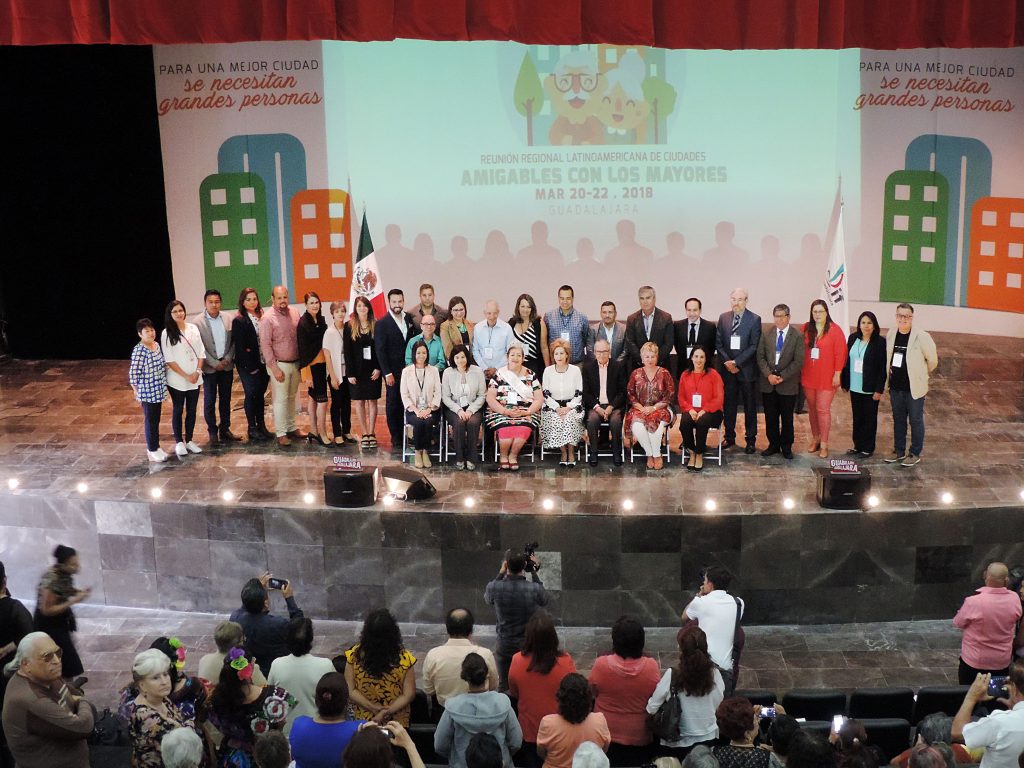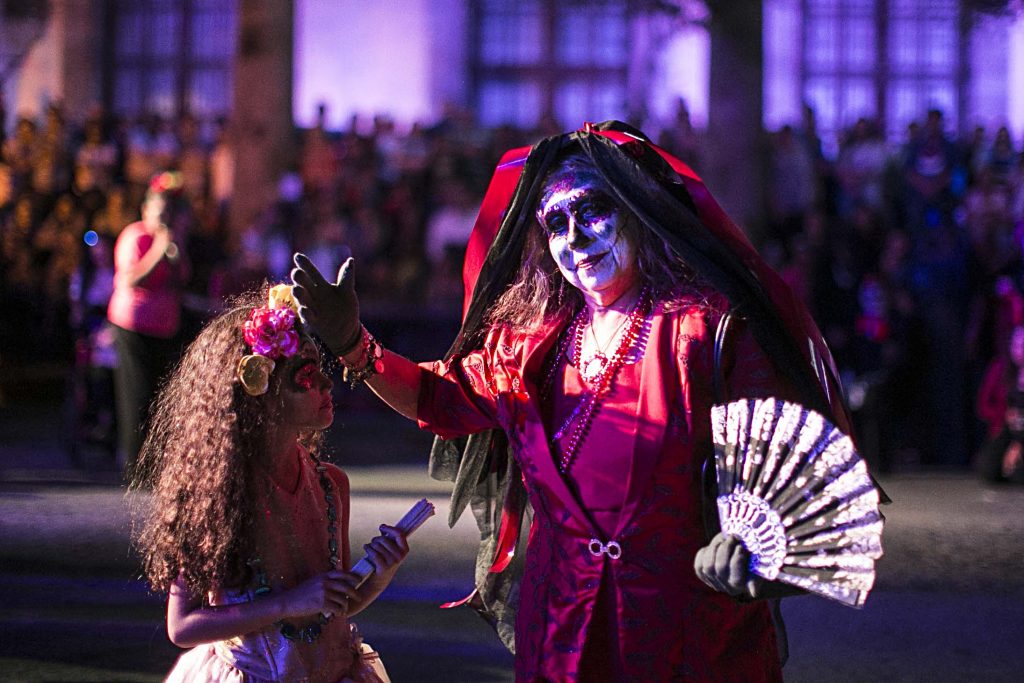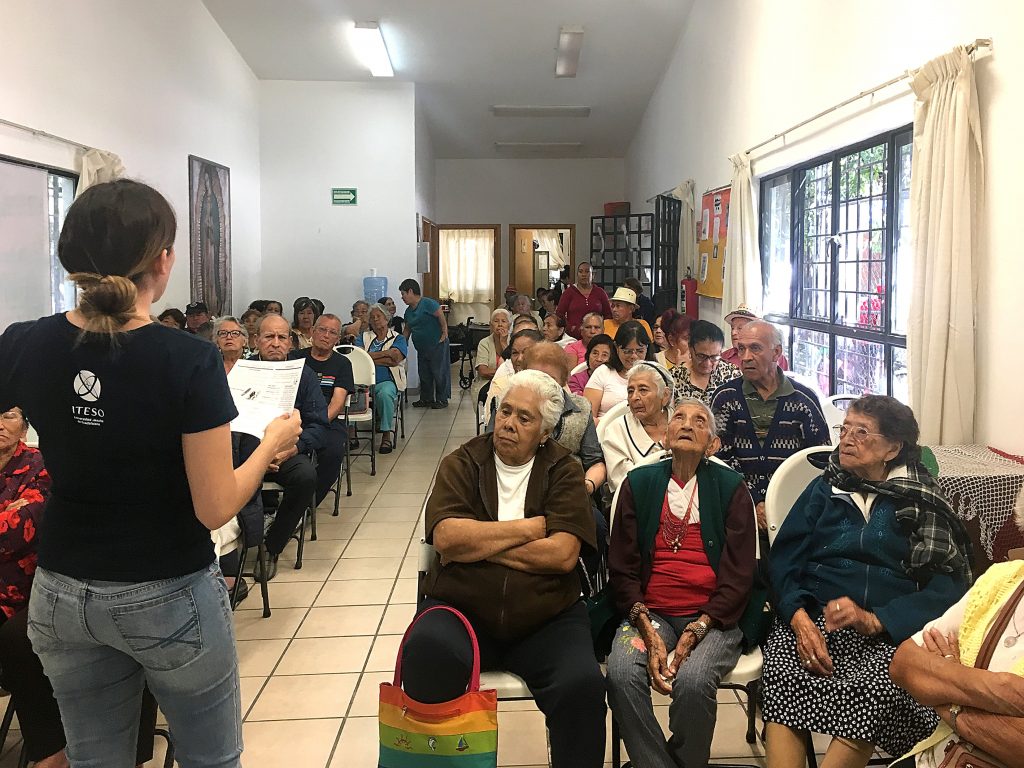Case Study: The Age-friendly Programme in Guadalajara
© Guadalajara, Mexico - Regional Meeting of Latin American Age-friendly Cities and Communities held in Guadalajara
Guadalajara joined the WHO Global Network for Age-Friendly Cities and Communities in December 2014 and its strategies to improve the quality of life of older residents have had a specific focus on living conditions among the most vulnerable populations. The priorities of the age-friendly programme are:
● social stewardship, including the responsible planning and management of resources by both public and private
institutions and civic organisations;
● the empowerment of older people, including encouraging older people to be more active in their own communities,
maximising their social participation;
● developing the cultural identity of the city in order to encourage a collective consciousness and sense of belonging among
communities within the city;
● collaborative working to establish the relationships that are vital for dissemination of the project and to raise awareness
of the issues surrounding ageing and growing old;
● generating knowledge in order to create public policies that meet the needs of specific groups.
The programme has reached almost 54,000 older people across different Guadalajara neighbourhoods. Areas with high numbers of people aged 60 and over and those with more marginalised populations have been of specific interest.
An inter-institutional team formed by the University of Guadalajara, the ITESO University, the College of Geriatrics, Psychogeriatrics and Medical Gerontology of the state of Jalisco, and an asylum NGO helped to develop and implement the city-wide programme. A wide range of stakeholders are involved in the age-friendly movement, including through the Citizen Council and its Council of Management Boards Representative of Older Persons (representing more than 5,000 older people), the Government’s Technical Committee, and various specialists, academics, and professionals. There has been a prominent role for older people in the development, monitoring, and evaluation of the priorities and actions.
A major factor in the success of the age-friendly programme in Guadalajara is the openness to views from different perspectives. Understanding that different groups of older people have different specific needs has been vital. It was similarly important to recognise that prior to the age-friendly programme the city was not meeting the basic needs of older people or promoting healthy and active ageing. This helped the programme team develop a realistic work plan with specific actions to make the city more age-friendly.
Challenges and Strategies for Progress
The city of Guadalajara, in the west of Mexico, is the country’s second largest city with a population of more than 1.5m people (The National Population Council (CONAPO)). Around one-third (31.7%) of the population are from a European background, 33.3% from an indigenous background, and 34.7% from a Mestizo background. Low fertility rates and increased life expectancy have resulted in an increasingly higher proportion of older adults. Between 1990 and 2017, the proportion of adults aged 60 and over increased from 6.8% to 10.5% and is expected to rise to 14.4% by 2030. The majority (54.8%) of older adults in Mexico live in urban areas. The most marginalised groups are the indigenous population and seven out of 10 indigenous language speakers reside in municipalities.
There are several challenges for the city. Firstly, the different stakeholders need to agree a long-term vision that is sustainable and solution-based. Secondly, it can be difficult to reconcile the protection and conservation of natural resources with the need to sustain economic growth. Thirdly, the ageing population will require a substantial shift in society, not only in terms of expanding services and resources but also to incorporate new strategies and programmes to meet the needs of an older population. Guadalajara’s strategies for success include close collaboration between public and private sector organisations, promoting social co-responsibility.
Age-friendly City Projects – Examples of Success
© Guadalajara, Mexico - An intergenerational cultural event
Implementation of the age-friendly programme has from the beginning involved three intersectoral groups: management, evaluation, and monitoring. This joint responsibility led to a number of initiatives including setting up a public attention training course to ensure that those working in the public sector understand and act sensitively towards the specific needs of older people. The strategy has also involved running initiatives first at the local level, which may include changing municipal laws and regulations and then expanding this to state level public policies.
© Guadalajara, Mexico - A workshop group of the Taking Control of Your Health programme
The Communication Programme for Healthy and Active Ageing has delivered several campaigns and workshops to promote healthy lifestyles for older adults. A programme titled Taking Control of your Health has been running since 2017 in collaboration with the Pan American Health Organisation and seeks to encourage healthier eating, physical activity, and maintaining healthy cognitive functioning. The aim is for 24 trained leaders to implement this programme for five different groups of older people across Guadalajara over two years. Around 2,400 people will have taken part by the end of 2018. Workshops have also been delivered by the ITESO University in community centres about improving the quality of life of older people through nutrition and architecture. Finally, a campaign to change perceptions of older people in order to reduce prejudice and discrimination was delivered, emphasising the need for inclusion and awareness of the needs of diverse groups of older groups.
© Guadalajara, Mexico - A university workshop programme
Under the Project of Comprehensive Urban Interventions approximately 741m Mexican pesos were invested in 2017 to improve the urban areas of Guadalajara, of which 22% was spent on interventions that directly benefited older people. This included purchasing comprehensive care equipment and services, improving green spaces, and sports and leisure centres. Some of the main aims of this project were to: improve the pavements and create safe pathways for all pedestrians; improve the infrastructure particularly in places where a lot of older people reside; improve public lighting and urban maintenance; adapt green spaces to the specific needs of older people; and ensure that public buildings are accessible to all. There has also been investment to expand and improve the Comprehensive Care Centre for older people by offering spaces for training, interaction, and rehabilitation, as well as integrating an aquatics complex to encourage physical strengthening among older people. A new health centre is also about to be opened that includes an area for hydrotherapy, general medicine, ophthalmology, and nutrition.
An intergenerational internship programme has been established, with the aim of creating an exchange of knowledge and experience between children, younger people, and older people. To date, more than 30 workshops have been implemented with the objective of promoting values such as respect, tolerance, understanding, and empathy. The programme develops recreational activities to encourage greater communication between generations, and physical activity programmes to promote healthy ageing across the life-course.
Future of Guadalajara’s Age-friendly Programme
The age-friendly programme was evaluated between July and October 2017 by 98 representatives of the senior management committees, which represent more than 5,000 older people living in the municipality of Guadalajara. The objectives of the evaluation exercise ranged from measuring the levels of participation and satisfaction, to monitoring the government’s implementation of policy changes. It found that satisfaction with living conditions among older people had increased by 15%.
Priorities for the future in terms of age-friendly policies in the city include the implementation of initiatives relating to the training of individuals working in care homes and providing services for older people, employment of older people, and the public safety programme for older people. Other areas in focus are to strengthen the participation of universities and colleges, and to establish a metropolitan network of age-friendly cities.
Acknowledgments: This case study was written in partnership with a team from the University of Manchester led by Tine Buffel and consisting of Tine Buffel, Natalie Cotterell, Chris Phillipson, and Samuèle Rémillard-Boilard; in collaboration with Karina Lizette Oliveros Moran and Jose Luis Jaramillo of Guadalajara.





